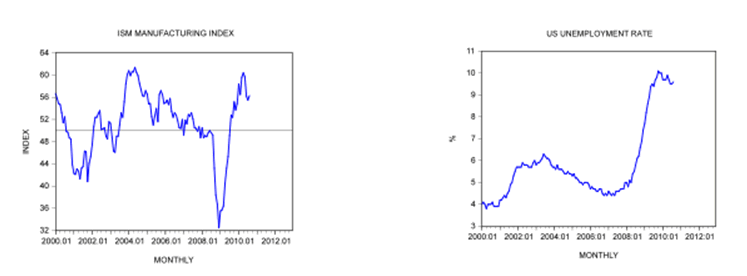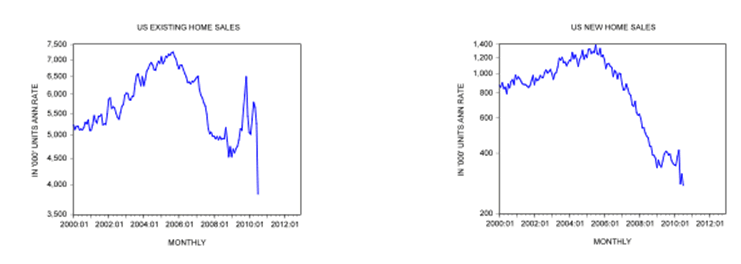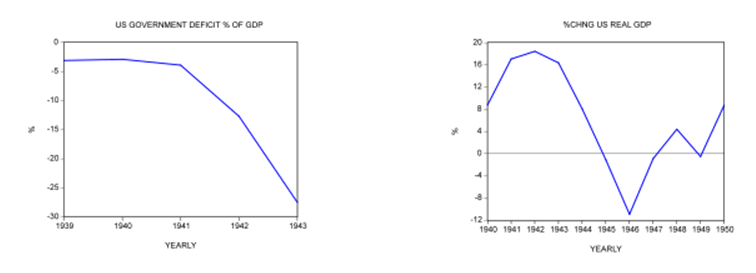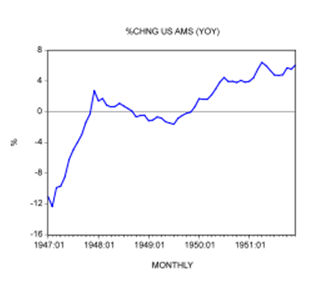Does the U.S. Economy Need Another Economic Stimulus Package?
Economics / Economic Stimulus Sep 17, 2010 - 12:38 PM GMTBy: Frank_Shostak
 Despite the massive fiscal stimulus package of nearly $800 billion approved by Congress early last year and trillions of dollars pumped by the Fed, the rally in various key economic data seems to be coming to an end.
Despite the massive fiscal stimulus package of nearly $800 billion approved by Congress early last year and trillions of dollars pumped by the Fed, the rally in various key economic data seems to be coming to an end.
After falling to 32.5 in December 2008, the ISM manufacturing index peaked at 60.4 in April of this this year.
In August the index stood at 56.3. Also, the unemployment rate remains stubbornly high at 9.6 percent, with almost 15 million Americans out of work.

Moreover, the housing market remains depressed despite the stimulus policies and record low interest rates. In July the yearly rate of growth of existing home sales plunged by 25.5 percent, while new home sales fell by 32.4 percent. According to the Fed's August report, known as the Beige Book, the US economy has shown widespread signs of slowing — with an ample supply of qualified applicants for open positions.

Against this background some economic commentators and President Barack Obama are of the view that there is a need for another stimulus program to lift the economy out of the black hole. In fact, on September 8 the US president proposed $50 billion more in infrastructure spending and a $100 billion extension to a tax credit on research and development.
But why should another stimulus program be effective given that the previous program appears to have failed?
Some commentators hold that the last year's stimulus package wasn't big enough to revive the economy. It is argued that, given a $15 trillion US economy in terms of GDP, the $800 billion was far too small to make a meaningful impact — a much larger stimulus is required.
For some commentators, such as Paul Krugman, only a very large stimulus program is likely to produce the needed result.
According to Krugman, the main focus of any stimulus program should be to generate as much employment as possible in a short period of time. With improved employment, consumer demand will follow suit, and this will lift the economy — so it is held.
This way of thinking is based on the view that initial increases in consumer outlays tend to set in motion a reinforcing process, which supposedly strengthens the total output in the economy, by a multiple of an initial quantity of spending.
The popularizer of the magical power of the multiplier, John Maynard Keynes, wrote,
If the Treasury were to fill old bottles with banknotes, bury them at suitable depths in disused coal mines which are then filled up to the surface with town rubbish, and leave it to private enterprise on well-tried principles of laissez-faire to dig the notes up again (the right to do so being obtained, of course by tendering for leases of the note-bearing territory), there need be no more unemployment and with the help of the repercussions, the real income of the community, and its capital wealth also, would probably become a good deal greater than it actually is.[1]
For Krugman and other Keynes followers the key here is monetary expenditure. The larger the expenditure, the larger the income and real economic growth is going to be.
Is Funding About Money?
The proponents of a larger economic-stimulus package also argue that in the present economic slump boosting employment by means of various stimulus programs is not going to be at the expense of other activities. This means that employing more Americans is going to be costless. According to the proponent of this view, Paul Krugman,
The point is right now we have mass unemployment. If you put 100,000 Americans to work right now digging ditches, it is not as if you are taking those 100,000 workers away from other good things they might be doing. You are putting them to work when they would have been doing nothing.[2]
But how is the increase in employment going to be funded? Who is going to pay for this? It seems that Krugman and most commentators hold that funding can be easily generated by the central bank by means of printing presses.
Contrary to what Krugman and other commentators claim, funding is not about money as such but about real savings — final consumer goods. It is the flow of final consumer goods and services that maintains people's lives and well-being.
When a baker trades his saved loaves of bread for potatoes he in fact provides a means of sustenance to the potato farmer. Equally, the potato farmer provides a means of sustenance, i.e., his saved potatoes, to the baker. Note that the real savings sustain producers in the various stages of production. (Real savings support the producers of intermediary goods and the producers of final consumer goods and services.)
Observe that in order to maintain their life and well-being, people require final goods and services and not money, which is just a medium of exchange. Money only helps to facilitate trade among producers — it doesn't generate any real stuff. Paraphrasing Jean-Baptiste Say, Mises wrote,
Commodities … are ultimately paid for not by money, but by other commodities. Money is merely the commonly used medium of exchange; it plays only an intermediary role. What the seller wants ultimately to receive in exchange for the commodities sold is other commodities.[3]
Various tools and machinery — or the infrastructure that people have established — are for only one purpose: to produce the final consumer goods that are required to maintain and promote people's lives and well-being.
The greater the production of consumer goods for a given consumption of the producers of these goods, the larger the pool of real savings or funding is going to be. A larger pool of real savings can now sustain more individuals to be employed to enhance and expand the infrastructure.
This of course means that through the increase in real savings a better infrastructure can be built. This in turn sets the platform for a higher economic growth.
Higher economic growth means a larger quantity of consumer goods, which in turn permits more savings and also more consumption. With more savings a more advanced infrastructure can be created, and this in turn sets the platform for a further strengthening in economic growth.
Note that the savers here are wealth generators. It is wealth generators that save and employ their real savings in the buildup of the infrastructure.
The savings of wealth generators are employed to fund various individuals who specialize in the making and the maintenance of the infrastructure. (Real savings also fund individuals that are engaged in the production of final consumer goods.)
Contrary to the claims of Krugman and other commentators, the artificial creation of employment (such as digging ditches) is not going to be cost free. The unemployed individuals that will be employed in useless projects must be funded. Since government doesn't produce any real wealth, the funding will have to be diverted from wealth-generating activities. This, however, is going to undermine wealth generators and is going to weaken the real wealth-generation process.
The following simple example encapsulates the situation: In an economy that is comprised of a baker, a shoemaker, and a tomato grower, another individual enters the scene. This individual is an enforcer who is exercising his demand for goods by means of force. Can such demand give rise to more output as the popular thinking has it? On the contrary, it will impoverish the producers. The baker, the shoemaker, and the farmer will be forced to part with their product in exchange for nothing, and this in turn will weaken the flow of production of final consumer goods.
Since government doesn't produce any real wealth, obviously it cannot save and therefore it cannot fund any activity. Hence for the government to engage in various activities, it must divert funding, i.e., real savings, from wealth generators.
Can Something Be Generated Out of Nothing?
Can an increase in the demand for consumer goods lead to an increase in the overall output by the multiple of the increase in demand, as suggested by Keynes and Krugman? If this can be achieved, then one could conclude that something useful can be generated out of nothing.
To be able to accommodate the increase in his demand for goods a baker must have the means of payment (i.e., bread) to pay for goods and services that he desires. For instance, the baker secures five tomatoes by paying for them with eight saved loaves of bread. Likewise, the shoemaker supports his demand for ten tomatoes with a saved pair of shoes. The tomato farmer supports his demand for bread and shoes with his saved fifteen tomatoes.
An increase in the supply of final goods permits an increase in demand for goods. Thus the baker's increase in the production of bread permits him to increase demand for other goods. In this sense, the increase in the production of goods gives rise to demand for goods. Please note again that people are engaged in production in order to be able to exercise demand for goods to maintain their life and well-being.
What enables the expansion in the supply of final consumer goods is the increase in capital goods or tools and machinery. What in turn permits the increase in tools and machinery is real savings. We can thus infer that the increase in consumption must be in line with the increase in production. From this we can deduce that an increase in consumption cannot cause production to increase by the multiple of the increase in consumption. The increase in production is in accordance with what the pool of real savings permits.
Production cannot expand without support from the pool of real savings, i.e., something cannot emerge out of nothing. This of course means that only wealth generators can set in motion an expansion in real wealth.
Why Data by Itself Cannot Produce Facts
How then are we to reconcile the so-called facts that are supposedly presented by various studies, i.e., the fact that stimulus programs can grow the economy? For instance, in his New York Times article from September 5, 2010, Paul Krugman suggests that it was the massive government borrowing during the war, from 1940 to 1945, that laid the foundation for long-run prosperity. Thus in 1943 the budget deficit as a percentage of GDP stood at almost 28 percent. The rate of growth in real GDP, after falling to minus 11 percent in 1946, jumped to almost 8 percent by 1951.

Note that the so-called economic growth here is assessed in terms of real GDP, which depicts monetary expenditure. Hence we suggest that an important force behind the strong increase in real GDP must be the monetary factor. Indeed, we had strong increase in the money-supply rate of growth from minus 11 percent in January 1947 to 6 percent in May 1951.

Now, even if we were to accept that notwithstanding all the shortcomings of real GDP and grant that the US economy had prosperity after 1946, it doesn't necessarily follow that this occurred on account of large budget deficits, as suggested by Paul Krugman and other commentators.
Contrary to the popular way of thinking, data cannot talk by itself and present so-called facts. The data must be assessed by means of a framework that can withstand some basic scrutiny — such as whether the government can grow the economy although it's not a wealth generator.
Once we reach the conclusion (based on logical analysis) that the government cannot grow the economy, we can emphatically reject various studies and assertions that tell us the exact opposite.
This means that the long-term prosperity in the United States took place on account of the expanding pool of real savings and in spite of aggressive government spending during the war. (We have seen that without the expansion in the pool of real savings no economic growth is possible.)
It must be realized that the data out of which various so-called facts are produced appear to support various empirical research conclusions as long as the private sector of the economy generates enough real savings to support productive and nonproductive activities. As long as this is the case, various so-called empirical studies can produce "support" for any pie-in-the-sky theory — such as the idea that the government can grow an economy and that something can be created out of nothing.
Whenever the ability of wealth generators to produce real savings is curtailed, economic growth follows suit and no amount of money that a government pushes into an economy can make it grow. (Again the government cannot create real savings, it can only divert the existing real savings from wealth generators.)
Once the process of wealth generation is damaged and loose policies become ineffective in "reviving" the economy, various commentators such as Krugman are quick to suggest that the laws of economics must have changed. For them this means forgetting logical analysis based on the essential laws of economics and going for massive spending. Now if the laws of economics have changed, on what grounds can Krugman and others employ events from the 1940s to make their policy recommendations? If everything is in a state of flux why should laws that were valid in 1940 be applicable today?
According to Krugman,
We are at unusual times where usual intuition doesn't apply here, getting this economy moving is the best thing we can do, not just for the present, but for the future and for our children.[4]
If the pool of real savings is in trouble, adopting Krugman's advice — i.e., introducing a massive fiscal stimulus package — will only make things much worse and plunge the US economy into a much more severe economic slump. If the pool of real savings is still holding, then there is no need for stimulus programs: the growing pool of real savings will revive the economy.
Conclusion
Despite the massive $800 billion fiscal stimulus package introduced last year, the US economy is struggling to recover. Various economic indicators, after having a short rebound, are starting to display visible weakening. Many experts, including President Barack Obama, are of the view that a larger fiscal stimulus package might do the trick. Our analysis indicates that not only can fiscal stimulus not revive the economy but, on the contrary, it can also make things much worse.
The key factor for a sustained economic recovery is the buildup of real savings. This buildup can only be secured by wealth generators and not by government spending, which weakens the process of wealth formation.
Frank Shostak is an adjunct scholar of the Mises Institute and a frequent contributor to Mises.org. He is chief economist of M.F. Global. Send him mail. See Frank Shostak's article archives. Comment on the blog.![]()
© 2010 Copyright Frank Shostak - All Rights Reserved Disclaimer: The above is a matter of opinion provided for general information purposes only and is not intended as investment advice. Information and analysis above are derived from sources and utilising methods believed to be reliable, but we cannot accept responsibility for any losses you may incur as a result of this analysis. Individuals should consult with their personal financial advisors.
© 2005-2022 http://www.MarketOracle.co.uk - The Market Oracle is a FREE Daily Financial Markets Analysis & Forecasting online publication.



